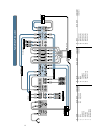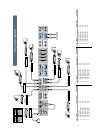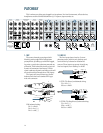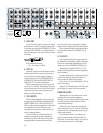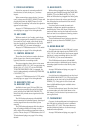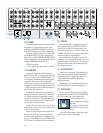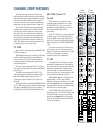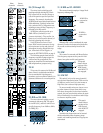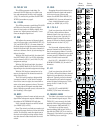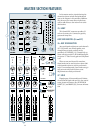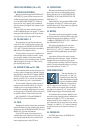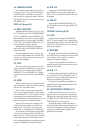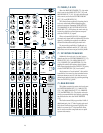
19
CHANNEL STRIP FEATURES
AUX SEND: (26 and 27)
26. AUX
These knobs tap a portion of each
channel signal and send it out, via the
AUX SENDS (10) jacks, to an amp &
speakers for stage monitors or to an ef-
fects device for parallel effects
processing.
Each AUX knob’s level ranges from off,
through unity (center detent position),
on up to 15dB of extra gain (fully clock-
wise). AUX levels are controlled by these
knobs and by the AUX SEND MASTERS
(46).
The stereo channels’ AUX knobs con-
trol a mono sum of the channel’s stereo
signals. For instance, channel 21 (L) and
22 (R) mix together to feed that
channel’s mono AUX send knobs.
27. PRE
Aux sends 1 & 2 are always pre-fader,
designed for stage monitor applications.
Aux sends 5 & 6 are always post-fader, de-
signed for parallel effects applications.
Aux sends 3 & 4, thanks to this switch,
can be set to be pre- or post-fader, so they
can be used for monitors or effects.
PRE-FADER: With the PRE switch en-
gaged (down), AUX 3 and 4 deliver
signals post-insert, post-low cut, post-EQ,
post-mute, pre-fader. Any changes made
to the channel controls, except the fader,
will affect the aux send signal.
POST-FADER: With the PRE switch
disengaged (up), AUX 3 and 4 deliver sig-
nals post-insert, post-low cut, post-EQ,
post-mute and post-fader. Any changes
made to the channel controls will affect
the aux send signal.
The channel strip is where you dress up
each channel’s audio: setting the gain, adding
EQ, riding the fader, tapping signal off to stage
monitors and effects devices. After a signal
leaves the channel strip it goes through a mix
stage and on to the master section (page 22).
The 24•4-VLZ PRO has 20 mono channels
and two stereo channels. The 32•4-VLZ PRO
has 28 mono channels and two stereo chan-
nels. All of the mono channels are identical,
and all of the stereo channels are identical. In
this chapter, both flavors are described with
the help of an illustration from the 24•4-VLZ
PRO. This shows a mono channel strip 20 and
its neighbor, the stereo strip 21/22.
25. TRIM
If you haven’t already, please read SET THE
LEVELS on page 8.
TRIM adjusts the input sensitivity of the mic
and line inputs connected to the channels,
mono or stereo. This allows signals from the
outside world to be adjusted to optimal inter-
nal operating levels.
Through a mono channel’s MIC (1) XLR in-
put, there is 0dB of gain fully down and 60dB of
gain fully up.
Through a mono channel’s LINE IN (2)
TRS input, there is 15dB of attenuation fully
down and 45dB of gain fully up; with a “U”
(unity gain) label at about 10:00 (knob one-
third up).
Through the stereo channel’s STEREO LINE
IN (4) TRS inputs, there is 20dB of attenuation
fully down and 20dB of gain fully up; with a “U”
(unity gain) label at 12:00 (knob halfway up).
dB
30
20
10
OO
40
50
5
5
U
60
10
dB
30
20
10
OO
40
50
5
5
U
60
10
LR LR
U
OO
+15
U
OO
+15
U
OO
+15
U
OO
+15
U
+15-15
U
+15-15
U
+15-15
U
+15-15
U
+15-15
U
+15-15
U
+15-15
U
OO
+15
U
OO
+15
U
OO
+15
U
OO
+15
U
OO
+15
U
OO
+15
U
OO
+15
U
OO
+15
-
20 +20
U
POST POST
POST
POST
+15dB
-
45dB
M
I
C
G
A
I
N
0
U
60
-
1
0
d
B
V
600
1.5k150
8k10 0
12k
HI
3k
MID
HI
800Hz
MID
LOW
EQ
LOW CUT
75 Hz
18dB/OCT
80Hz
LOW
80Hz
LOW
3
-
4
L
-
R
1
-
2
3
-
4
L
-
R
1
-
2
-20
OL
-20
OL
PRE
1
PRE
PRE
2
3
5
6
12k
HI
MID
FREQ
TRIM
20
TRIM
21
22
AUX
PRE
1
PRE
PRE
2
3
5
6
AUX
20
MUTE
EQ
21 22
MUTE
SOLO
SOLO
PAN PAN
44
MUTE /
SOLO
MUTE /
SOLO
MUTE /
SOLO
MUTE /
SOLO
Mono
channels
Stereo
channels




